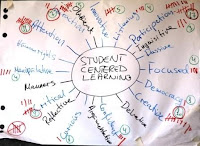We at Juba Technical Secondary School think that a Student Centered Learning approach enables the students to learn for life in a better way than the traditional teacher centered method. Therefore we will move step by step in that direction.
This was the conclusion of the teachers and the management of the school after having experienced an experiential, collaborative student centered learning environment while exploring the topic of Student Centered Learning.
Tuesday September 15th was the first of three days in a workshop arranged for the management and teachers at Juba Technical Secondary School by Upper Nile University in collaboration with Akershus University College.
The leadership and teachers of Juba Technical Secondary School experienced Student Centered Learning as students in their process of the initial molding of a shared vision of Student Centered Learning at their school.
 The participants generated a set of Characteristics of Student Centered Learning. Each of them was then given five votes to prioritize among the characteristics. The participants generated a set of Characteristics of Student Centered Learning. Each of them was then given five votes to prioritize among the characteristics. |
The workshop participants soon were reminded that a word can have various meanings. A loosely, if at all defined concept like Student Centered Learning proved rightly to be understood vaguely. They learned that it requires significant efforts to obtain Student Centered Learning to become a shared vision. But that was not blocking them from taking on the job with eagerness and determination.
The real challenges came when the participants were invited into a process of defining what they regarded as evidence of the teacher’s facilitation of Student Centered Learning. It seemed that the actions of the teachers defined as evidence for the teacher’s facilitation of a student centered learning environment often were actions which could be performed by active and able students. Before they had defined what they regarded as evidence of the students learning in a student centered learning environment.
From a learning perspective it is my experience that it is usual that changing my behavior is not easy. I actually think most of us are likely to continue doing what we have been doing before. So did the teachers do when they defined their actions which they regarded as proof of them facilitating a student centered learning. They described their continued orchestrating in class with the focus on them selves more than the students. Their planned actions were often focused on them telling the students to participate, not allowing the students the space needed to take the initiative and to be active learners resposible for their own learning.
Most probably most of the students will also expect to be told by the taechers at school when that's what they through years have experienced that students are at school. It is probably so that both the teachers and the students at Juba Technical Secondary School will have to learn how to learn in a Student Centered Learning environment. And most probably they will find it to be hard work too, but that is what real learning sometimes is.
Juba Technical Secondary School is for the time being the only technical school in operation in Southern Sudan which size is twice the area of Norway and twice the population too. The school has a teaching staff of 21 and is offering three years programs for 259 students whom when graduating will be both holding technical vocational skills and Sudan Technical School Certificate allowing them to enter higher or tertiary education. The school has departments for building and construction, auto mechanics, auto mechanics, bricklaying, carpentry&joinery and metal work. The rehabilitation of the school was funded by Plan Norway through Plan International. Unfortunately there are yet no dormitories at the school.
1 comment:
Dear Trond:
We as Sudanese appreciate your tremendous effort which you and NUCOOP have done in this workshop and in the Southern Sudan in general.
It `s interesting to know how the participants from Juba Technical Secondary School accepted with appreciation the concept of student centered leaning. The real challenge, I think, is how to apply the concept in reality. Due to my experience at PGDVP is not easy to follow this pedagogical track for those who are not used to it. They soon divert to their usual and ordinary way of teaching, blocking by this the students from their own right of creativity and innovation.
As you put it, both, the teachers and the students should be aware of their own role in the leaning process.
I think, it will be beneficial to facilitate more workshops so the teachers can build awareness based on their consciousness as facilitators, i.e. to make the teachers behave as practitioners who suppose to ask themselves question of the kind of “HOW CAN I IMPROVE MY PRACTICE”. This requires from them to dig into their methodology of facilitating leaning critically.
I think this is going to lead to conscious and gradual transformation from teachers to facilitators.
Post a Comment